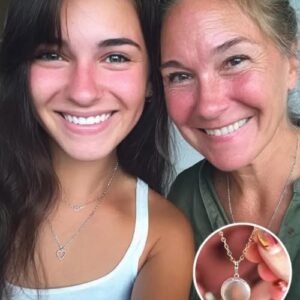Chapter I: Joy and Accusation at the Hospital
1.1 The Miracle of Birth
On a crisp autumn morning, Rosie Evans awakened in the labor ward of St. Mary’s Hospital. The soft hum of monitors and the gentle rustle of nurses’ scrubs framed the gravity of the moment. Eight hours after a successful C-section, Rosie felt Amelia’s tiny hand grasp her finger. The new mother’s eyes filled with tears as she took in the sight of her daughter—delicate, alert, and impossibly perfect.
Tim (whispering): “She’s everything we dreamed of, Rosie.”
Rosie (softly): “She’s beautiful, Tim. Thank you.”
As father and daughter shared their first silent exchange across Rosie’s hospital bed, the room’s warmth felt complete—until the door burst open.
1.2 Mother-in-Law’s Unannounced Entrance
Without knocking, Janet Harper strode in, her designer handbag swinging. Her painted smile wavered as she caught sight of Rosie cradling Amelia.
Janet (brightly): “Let me see my granddaughter!”
Rosie hesitated, glancing apologetically at Tim, but handed over her sleeping daughter. In that moment, Janet’s lips thinned, and her gaze sharpened.
1.3 The Cruel Accusation
Janet studied Amelia’s deep brown complexion as though inspecting a problem. Then she fixed Rosie with an icy stare.
Janet: “There’s no way this baby is Tim’s. You must have… taken liberties.”
Rosie’s world tilted. In a single sentence, Janet erased months of happiness and goodwill. Tim, summoned by his ringing phone, stepped in and immediately understood.
Tim (fierce): “Mom—”
Janet cut him off.
Janet: “Don’t lie to me. I know what I see.”
Before Rosie could speak, Tim’s phone buzzed urgency—a neonatal nurse requesting his signature on Amelia’s wrist-band paperwork. Janet departed with a condescending “Think it over,” leaving Rosie staring at her daughter, stunned.
Chapter II: Uncovering Hidden Heritage
2.1 Homeward Bound, Hearts in Turmoil
Back home, Rosie packed away hospital gowns and prepared for the challenge of parenting—and of confronting Janet’s cruelty. Sleepless nights blurred into days of pediatrician visits and feedings on demand, yet Rosie’s mind kept returning to Janet’s words: “This baby isn’t yours.”
Tim sat beside her one afternoon, reviewing genealogy documents.
Tim: “Rosie, I dug into my family tree. My great-grandfather was Black—a fact the family quietly buried.”
He produced an old sepia-toned photograph: a man with dignified posture and a mustache, labeled “Samuel Evans, circa 1920.” Rosie studied the face—strikingly equine eyes and strong features that Amelia clearly inherited.
Rosie: “So Amelia’s complexion comes from your grandfather. That makes perfect sense.”
Tim: “It does. And it also explains why my parents never mentioned him.”
Their discovery thrilled Rosie—Amelia was a living connection to a proud but hidden lineage. Yet it also deepened their resolve: if Janet refused to accept this truth, Rosie and Tim would have to confront her prejudice head-on.
2.2 Preparing for the Showdown
Over the next two weeks, Rosie and Tim prepared emotionally and logistically. They:
-
Educated Themselves: Consulted historians on the Evans family’s roots in Mississippi, collecting documents and photos to illustrate their heritage.
-
Built an Online Archive: Created a secure digital album of family artifacts—passports, census records, wedding certificates—demonstrating their ancestry.
-
Set Legal Safeguards: Updated guardianship and custody documents to ensure Janet could not unilaterally remove Amelia.
-
Coded a Peace Plan: Drafted a conversation guide for confronting Janet, grounded in facts and family unity.
By the time they returned home from Amelia’s two-week pediatric checkup, they felt stronger, informed, and ready to defend their daughter’s place in the family.
Chapter III: The Black Nursery
3.1 Anticipation Turns to Horror
On a chilly morning, Rosie carried Amelia—wrapped in a pastel blanket—toward the nursery, humming a lullaby. The memory of pink walls and stuffed animals lit up her thoughts. Stepping through the doorway, all light drained away.
The walls, once a soft rose hue, were now a flat, opaque black. The white crib lay in jagged pieces, its rails splintered. The canopy curtains had vanished, replaced by heavy charcoal drapes that choked the window. Not a single toy remained—bare shelves stared like empty graves.
Rosie gasped, dropping Amelia into her bassinet with shaking hands.
Rosie (whispering): “No… no, this can’t be real.”
3.2 Confronting Janet’s Justification
Janet stood near the doorway, chin raised, arms folded.
Janet: “I thought the room needed fixing. Pink is… too cutesy for a baby who isn’t even your own.”
Rosie’s shock dissolved into rage.
Rosie: “You destroyed her nursery! You smashed her crib! How dare you—”
Janet interrupted with a sneer.
Janet: “That baby has my son’s looks, but she isn’t his daughter. I’m saving you the trouble of admitting your betrayal.”
Tears blurred Rosie’s vision. Tim, arriving by the back staircase, saw the devastation and Janet’s hateful expression.
Tim (furious whisper): “Get out.”
Janet’s lip curled in contempt.
Janet: “I’ll leave when you send that child back to her real mother.”
She swept from the room, the door slamming behind her.
3.3 Documenting the Damage
Once Janet had gone, Rosie and Tim meticulously photographed the scene:
-
Wide shots of the entire nursery, highlighting the stark contrast.
-
Close-ups of shattered crib rails and paint streaks.
-
Vacant shelves, capturing the total removal of toys.
They logged each detail in a dated inventory—evidence for the police and any future legal proceedings. Trembling, Rosie filled out an incident report with the local police department and filed a claim with their homeowners’ insurer.
Chapter IV: Rallying Support and Seeking Justice
4.1 Contacting Authorities and Professionals
Shaken but resolute, Rosie and Tim reached out immediately for help:
-
Law Enforcement: They filed a police report detailing the vandalism, Janet’s admission of intent, and their documentation of the damage. Detective Laura Kim took their statement and assured them that malicious property destruction and hate-motivated crimes would be thoroughly investigated.
-
Homeowners’ Insurance: Rosie submitted her photographs and the police report to their insurer. Within 48 hours, the claims adjuster approved coverage for the nursery’s repair and replacement of the crib, paint, and furnishings—allowing Rosie and Tim to focus on healing rather than financial strain.
-
Family Attorney: They consulted Marianne Lopez, a family-law attorney, to review custody papers and draft a “no-contact” directive; Janet would be legally barred from entering their home or contacting Amelia without written permission.
Ms. Lopez: “Your primary concern is Amelia’s safety and wellbeing. These steps will create a secure environment and deter future incidents.”
4.2 Turning to Social Media
To galvanize community support—and warn others—Rosie carefully crafted a public post:
“Today, my daughter’s nursery was destroyed by her own grandmother. Because of her racism and refusal to accept Amelia, our nursery was painted black, the crib smashed, and every toy removed. We have evidence and the police are involved. Hate has no place in our family or community. #JusticeForAmelia”
Within hours, the post spread across parenting groups and neighborhood forums. Neighbors, friends, and even local news outlets expressed outrage and solidarity. A GoFundMe page, started by Rosie’s college roommate, raised funds to cover any unexpected costs and to donate to a local children’s anti-bias education charity in Amelia’s name.
Chapter V: Rebuilding a Sanctuary of Love
5.1 Designing the New Nursery
Once police gave the green light to contractors, Rosie and Tim reimagined the nursery not as a restoration but as a rebirth:
-
Walls: A soft gradient from sunrise peach to dawn-blue, symbolizing hope after darkness.
-
Crib: A sturdy, solid-wood model with high sides, ensuring safety and permanence.
-
Furnishings: Ethically sourced wooden shelves for toys, a rocking chair reupholstered in breathable pastel linen, and blackout curtains with cheerful star patterns.
-
Décor: A hand-painted mural of Amelia’s initials intertwined with white blossoms, created by a local artist inspired by her story.
Rosie oversaw every detail, viewing each choice as an affirmation of love and resilience. When the nursery was complete, she invited friends and family for a “Welcome Home” gathering. As Amelia cooed in her new crib, Rosie whispered:
Rosie: “This room is your promise, sweetheart—no darkness can stay here.”
5.2 Family Unity Restored
Linda Harper, served with the no-contact order, watched from afar as social media celebrated the new nursery. Shamed by public condemnation and moved by offers to counsel her on racial sensitivity, she quietly reached out—through Ms. Lopez—to express remorse and request a pathway to redemption.
Jane and Tim, mindful of empathy but firm on boundaries, proposed a three-step reconciliation:
-
Racial-Bias Training: Linda would complete a certified online course on unconscious bias.
-
Charitable Contribution: She would match the funds raised for the anti-bias education charity.
-
Mediated Meeting: A formal session, facilitated by Detective Kim and Marianne Lopez, to discuss her apology and path forward.
When Linda agreed and fulfilled each step over the next two months, Rosie and Tim lifted the no-contact order—allowing carefully supervised visits in neutral settings.
Chapter VI: Expert Perspectives on Confronting Familial Prejudice
6.1 Child-Development and Safety
Dr. Amina Shah, a pediatric psychologist, emphasizes the importance of protecting a child’s early environment:
“Infants sensitize to emotional climates. A bright, stable nursery fosters security and healthy attachment. Acts of vandalism by a caregiver can undermine that foundation. Rosie and Tim’s swift legal and environmental responses were critical to safeguarding Amelia’s emotional development.”
6.2 Addressing Racism Within Families
Professor Marcus Liu, a specialist in family studies, notes:
“Confronting a relative’s racism requires both boundary-setting and opportunities for education. The Evanses’ insistence on training and public accountability—balanced with eventual forgiveness—models a constructive approach rather than endless estrangement or passive acceptance.”
Chapter VII: Reflections on Identity, Belonging, and Unconditional Love
7.1 Embracing Diverse Heritage
As Amelia grows, Rosie and Tim cherish her link to her great-great-grandfather’s legacy. Family gatherings now include stories of Samuel Evans, celebrating a multi-ethnic heritage that Janet once tried to erase.
7.2 Love as the Ultimate Truth
In the end, it was Amelia’s smile—pure, unselfconscious—that affirmed Rosie and Tim’s conviction. Their daughter’s happiness and security became the measure of their success, overriding any attempt at bigotry or division.
Rosie: “No matter what others say, our love for Amelia defines her identity—not hate.”
Chapter VIII: Practical Guidance for Readers
-
Document Immediately: Photograph vandalism and threats as evidence.
-
Engage Authority: File police reports, insurance claims, and legal orders swiftly.
-
Establish Boundaries: Draft clear, written family agreements on contact and behavior.
-
Leverage Community: Use social media and local networks for support and accountability.
-
Rebuild Thoughtfully: Transform harm into hope through symbolic redesign and community rituals.
-
Educate Aggressors: Encourage bias training and charitable contributions to facilitate genuine change.
-
Center the Child: Always prioritize the child’s emotional and physical safety in decision-making.
Epilogue: A Family Transformed
One year later, Amelia’s first birthday party filled the refurbished nursery with laughter. Linda Harper, now a changed woman, presented Amelia with a handcrafted quilt bearing the Evans family tree. Tears filled Rosie’s eyes as she embraced her mother-in-law—a gesture of forgiveness earned through accountability and understanding.
Tim (raising a glass): “To family—growing stronger in love, diversity, and unity.”
All (clinking glasses): “To Amelia!”
In the end, the darkness that once threatened to overshadow their home only served to illuminate the true strength of the Evans family: love that transcends prejudice, resilience that rebuilds joy, and unity that welcomes every shade of heritage.





